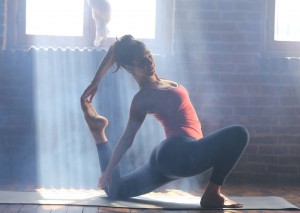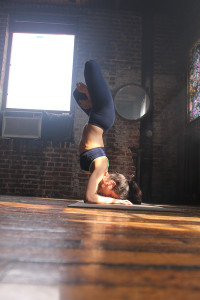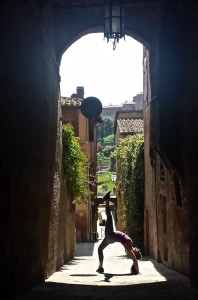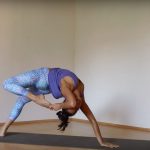Is Asana Yoga? ~ Maya Devi Georg

Maya Devi Georg
Yoga asanas, the physical exercises most folks simply call ‘yoga,’ are seen everywhere. Social media, gyms, parks, ads; it’s as popular today as aerobics was in the 1980’s. And why not? Part gymnastics, part contortion, part yoga pants – it’s as sexy as it is trendy.
But is it yoga?
Yoga is supposed to be a spiritual practice. The goal of Yoga is to release the practitioner from the binds of karma that keep them chained to the cycle of death and rebirth, and lead them into enlightenment. Just how can a workout do that?
Most forms of yoga focus on meditation and view the physical body as an impediment or obstacle to overcome. Other obstacles include the ego and the mind. These forms of yoga pretty much ignore the body, preferring to focus on controlling the mind and breath, or, to control the flow of energy in the body. They try to conquer the subtle, and ignore the gross.
It is only Hatha Yoga that directly deals with the physical body by incorporating Asana into the practice. No – Hatha Yoga is not a super gentle and slow style of asana! It is the blanket term for a form of yoga practice that includes physical exercises!
Hatha Yoga seeks to conquer the body, and work from the outside in. The first step is to learn to control the body, then the breath, then the mind. Hatha Yoga as a practice can be broken down into 3 parts: shatkarmas (cleansing practices), yoga asana (exercise), and pranayama (breathing practices).
Examples of Hatha Yoga include Sivananda, Iyengar, Vinyasa, and anything else that includes yoga poses. Some styles of yoga like Ashtanga and Kundalini can be misleading because their names refer to other forms of yoga.
Classical Ashtanga Yoga is a synonym for Raja Yoga, a practice that also includes pranayama, but stresses a form of meditation that is based upon focused concentration. The Yoga Sutras of Patanjali is a Raja Yoga text, and the brief mention of ‘asana’ within it is actually referring to a state of mind – not a physical practice. Ashtanga Yoga as taught by Pattabhi Jois, a very popular form of Hatha Yoga, is a vigorous practice focused on asana and pranayama. They are not the same type of practice.

Another example of this is Kundalini Yoga. Classical Kundalini Yoga (sometimes called Laya Yoga) is a practice that seeks to use the subtle energies of the body, releasing stored karma’s and awakening a state of bliss that leads to enlightenment. When these karma’s are released the meditator may twitch or spasm. These physical responses are called kriyas. Kundalini Yoga as taught by Yogi Bhajan is another form of Hatha Yoga. He developed this powerful style of Hatha Yoga by creating sequences that replicated kriyas, looking to recreate the same release by working from the physical to the more subtle. Again, the two are not the same kind of yoga practice.
In Raja Yoga, the goal is samadhi (single pointed concentration). In Kundalini Yoga the goal is to use subtle energy within the body to release karma’s and attain enlightenment.
The goal of Hatha Yoga is to prepare for Raja Yoga.
Hatha Yoga is a preparatory practice. It prepares us for higher forms of yoga practices, like meditation, yama & niyama, and eventually enlightenment. Yoga, and all its practices, prepares us to be better individuals.
But people practice for many reasons. Some for fitness, others for relaxation, some for general self-improvement, and some for the original goal: enlightenment. There are as many ways to practice asana as there are practitioners, and the goals are not always the same.
Asana alone isn’t yoga, but it can become yoga if we set our intention toward a goal of self-improvement when we practice!
Here are 5 ways asana is part of a yoga practice:
Physical Fitness
While focusing on washboard abs and buns ‘o steel may hardly seem like a spiritual path, using asana as a means of physical fitness is still part of the practice.
The earliest text that mentions asana, The Yoga Yajnavalkya (dated between the 4th and 2nd century BCE), discusses asanas and pranayamas and their use in Ayurveda as preventative medicine. Simply put, asana is used to keep the body healthy enough to practice, and to live long enough to attain the goals of yoga.
Keep in mind that the last asana you will ever do is savasana – as you age the body will lose its ability to do asana, so don’t get attached to the poses or your appearance! Growing old is better than dying young, so don’t fall into traps of vanity and ego – they will only lead to disappointment.
Learning Non-Attachment
It is said that the greatest fear and final obstruction to a yoga practice is the death of the body. And Hatha Yoga teaches us that we are not our bodies nor our minds.
One of the first things people experience when they begin to practice Hatha Yoga is a heightened sensory awareness of their bodies. With time and experience practitioners begin to realize that the physical sensations of the body does not define them and that the body is not their identity. The body is your vehicle and your responsibility, but it isn’t your true Self. As individuals get deeper into their practice, pairing breath and movement in asana, and watching the mind, they may begin to realize that identifying with the mind is also false.
I once had a teacher that taught that the true Self is eternal and unchanging, and anything that changes is not real. Our bodies and minds are always changing. Finding our way back to our infinite and immortal Self is the goal of yoga.
It is no accident that Shiva is both god of yoga and destruction. Enlightenment is a destructive process – it destroys our ego, our identity, and frees us from the trap of attachment, even as it guides us to our true Self.
Preparation for Meditation
It is theorized that the first yoga asanas that were performed and taught were seated meditative postures. And asana is a great preparation for long periods of seated meditation.
Asana teaches the individual the necessary discipline required to conquer the mind by first conquering the body. If you lack the discipline and determination required to control our body, chances are trying to control our mind, a far more challenging feat, will fail.
Asana also builds the necessary strength and flexibility needed to sit comfortably in meditation for extended periods of time. Now, being able to sit in a perfect padmasana (lotus pose) is not a requirement for meditation. But comfortably sitting in stillness, regardless of position, is.

Tapping Into The Subtle
Working from the gross physical body to the subtle flow of energy is not easy, and learning to feel and experience that flow in asanas is probably the most challenging way to use asana.
In mudra, hand gestures, the goal is to align subtle channels and allow energy to flow in new and unique patterns. This builds new circuits of energy, allowing the energy flow to flush away karmas, open new pathways, and cultivate more (and varied) subtle energy.
Asana can do the same, only on a bigger scale. The biggest challenge here is first to feel the subtle energy, then to feel the changes of the energy within asana, and finally to be able to consciously move the energy without the benefit of the asana.
This cannot be taught, and takes decades, or even lifetimes to master. So, good luck with that!
Devotion
If the previous option seems unattainable, fret not for I have good news!
The easiest way to use asana as a spiritual practice is through devotion. It’s simple: just offer the poses. It doesn’t matter to who or to what. Offer it to your favorite deity, offer it to your sick friend, offer it to the hopeless, or the helpless. It doesn’t matter who or what the object of your devotion is – just give it away.
This is actually the one time Hatha Yoga can become a different form of Yoga, it can become Bhakti Yoga, the yoga of love and devotion. In chapter 12 of the Bhagavad Gita Krishna explains that Bhakti yoga is the highest practice:
“Those who set their hearts on me and worship me with unfailing devotion and faith are more established in yoga.”
Krishna himself says this path is best. Bhakti Yoga, like all other forms of yoga, is still challenging. You can’t love everyone all the time – but you can try! And the more love you give, the more you transform yourself, your community, and the world.
Yoga is really about transformation. It is about trying to be and do better in the world so we can improve it. And while this may seem like an external practice, it isn’t. Yoga is deeply personal, and so are the experiences we have when we practice.
There are as many forms of the practice as there are practitioners, this is not an accident. So when we find our path, we must set our intention. The path leads beyond expectations and into unknown territory. Some may intend to transform their bodies, and end up transforming their lives.


